by
Venanzio Vallerani, M.D. in Agricultural Sciences
Roberto Maglione, MSc
Mirko Kulig, BSc in Computer Science
1 Introduction
What follows is a first draft version of the project. Many details still have to be discussed. Also, a more detailed cost analysis can only be done once the area that has to be worked on will be defined.
1.1 Objectives
In this project we intend to practically integrate two established techniques which have so far only been used independently, with the goal of increasing crop production and encourage reforestation in arid and semi-arid areas. The techniques are:
- The Vallerani System for reforestation and increasing crop production
- Modern rain increasing techniques
With this new approach we can work on all stages of the process of restoring to previous health dry areas, generally bordering deserts, which have become or are becoming too arid for the sustenance of human life.
We intend to use these techniques in a non-invasive way, only in such a manner that natural processes and rhythms will be stimulated by our intervention. Ultimately, our work should allow the reestablishment of normal self-sustaining weather and raining patterns which have been perturbed by human interactions such as pollution, deforestation, overpopulation, hunting, overgrazing, bad resources management and war.
1.2 Analysis of the problem
Desertification is a worldwide phenomenon and affects about 41% of the earth’s landmass. In these areas live over one billion poor or vulnerable people. Natural deserts constitute one of many ecosystems on earth. By contrast the process of desertification involves a gradual depletion of soil productivity and biodiversity of which man is the main cause. The process of desertification increases by 12 million hectares per year and covers all continents. In Africa alone, 70% of agricultural land is already degraded and threatened by desertification. This situation affects 250 million people of which 218 million are suffering from hunger. In sub-sahelian zone 750.000 hectares of woods and forests are lost every year ( FAO 2005 data). At the present stage we will not go into details about which human activities have brought to the present situation, as this is more of a global, social and economical problem and thus lies outside our objectives. Fact is that by reducing the green cover of vast areas of land, weather patterns have consequently also been changed with rainy seasons becoming shorter and with less abundant precipitations. This in turn has caused the decrease of underground water resources, the drying out of soils which have become unable to sustain agriculture, and finally mass migrations of peoples into more life-friendly regions.
Furthermore, dry clay soils, once stripped of their vegetation, become impermeable to water and so most of the rain that falls during rainy seasons will just flow away into creeks and rivers so failing to refill underground water tables as well as causing floods downstream. Other direct consequences are erosion, the formation of fine particles which affect rainfall and the increase of sand storm events.
1.3 Assessment for effective intervention
This said, we believe that the following steps need to be taken in order to restore the areas at risk:
- Reestablish natural weather patterns
- Allow the rain that falls to stay in place and not to flow away
- Increase natural vegetation cover
These processes are intimately interconnected, because once rain has been increased and allowed to stay in place, humidity will increase as well thus generating more rain and boosting plant growth, which in turn will also allow moisture to stay in place so extending the duration of rainy seasons to their natural time-frame.
Once these first goals have been reached, agriculture has to be reintroduced and encouraged in order to accelerate the return to an environment that can sustain human life.
1.4 Benefits
With the techniques we intend to use all of these objectives can be achieved in relatively short term, but with important social, economical and natural benefits, such as:
- increase of water available for life in arid ecosystems
- return to natural self-sustaining weather patterns
- reforestation of arid regions
- increased capability of weak ecosystems to support human life
- increased crop production
- increased livestock breeding
- less famine
- less human diseases caused by lack of fundamental nutrients
- less mass migration of peoples from arid areas to richer ecosystems
- less wars caused by competition between peoples for the limited natural resources of such areas
A detailed description of the techniques we want to use and how we intend to integrate them to improve the individual advantages that each one can provide follows below.
2 Vallerani System[1]
2.1 History
This system is based on the work of the Italian agronomist Venanzio Vallerani, M.D. He has worked on zoo technical and reforestation projects all over the world, from Brazil, to Africa, and as far as China. In the 1980s he accepted the invitation of a FAO member to visit Mozambique, which introduced him to the dynamics that brought a once lush and fertile continent to the present economic, social and political disaster. To quote his words:
“In the 1980s I could thus see charming Africa, particularly the Sahel, lose its trees. At first because of drought, then because of the increase in population and the following increase of human pressure on already depleted resources. I’ve seen the trees cut down because of the need for new farming land for family use, I’ve seen the soil burned by the sun becoming rapidly hard until it became unproductive, and finally I’ve seen water wells drying up and families leaving their homes and fields, the cities swelling up and becoming unsafe, societies confronting emigrations and wars.”
He thus concluded that every human action must be done in such a way that it should not compromise the sustenance of life on earth, and from the mid-eighties on he started to work wherever he was called according to the idea of increasing natural resources.
In the following years, through careful observation of natural processes, he was able to devise the techniques and methodologies which have become the Vallerani System.
Since then, this System has successfully been applied in the following countries:
Niger (1989, 2003-2007)
Morocco (1989)
Egypt (1989)
Tunisia (1995)
Senegal (1996, 2003-2007)
Burkina Faso (1997, 2000, 2001, 2003-2007)
Chad (1997-98, 2003-2007)
Sudan (2003-2007)
Kenia (2003-2007)
Siria (2003-2006)
Jordan (2003-2006)
China (Inner Mongolia, 2003-2006)
Many of these projects are still ongoing.
To be noted that among the many awards and acknowledgments he has received for his work, he has been nominated “Professor Honoris Causa for the prevention and combating of desertification” by the Inner Mongolia Academy of Forestry (AFIP) and the University of Ulun Beir, “Special Advisor for Accademy forestry inventory and planning of state forestry administration” of the Chinese Ministry of Forestry and President Hu Jintao awarded him with the “Certificate of Friendschip” the highest honor bestowed by the Chinese government to a foreigner.
2.2 How it works
The Vallerani System uses specially conceived plows that create a system of micro-basins which collect rainwater, over flow and other resources available like fine soil, organic matter, seeds, etc.
Up to 2011 the VS used a 180 hp farm tractor with two plows, the “Delfino” (literally translated in dolphin) and the “Treno” (literally translated in train).
Since June 2011 the VS has been enriched by a new plow: Delfino³ which is an evolution of the previous two plows Treno and Delfino. It brings their benefits together and enhances them with a revolutionary new conception of the function of ploughing in areas with low rainfall.
The new Delfino³ plow has a single reversible plowshare which through a wave motion digs crescents or micro basins 5 meters long, 50 cm deep and spaced about 2 m. Even with very low rainfall (1500-500mm/year) each micro-basin can collect over 1000 litres of water, including runoff.
Two ripper placed before the back labour body work the soil to a depth of 80 cm. Rise at the crescent and descend between the crescents. Thus to attain, in the stretch of land between the crescents, a collection bag which receives water from the crescents itself. This water is protected against evaporation and remains available to plant roots and groundwater. The two rippers are staggered so as to move any surface stone.
The Delfino3 needs to be pulled by a 210 hp tractor fitted with wide forestation tires, maximum ballast and hubs to enlarge the track.
The new Delfino3 plow
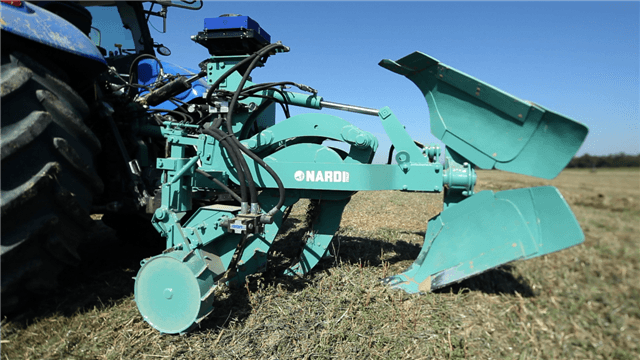
Previous special plows of the VS


Delfino plow Treno plow
The Vallerani System allows for direct seeding of native plants (possibly supplemented by transplantation of nursery species) whose germination and growth is possible thanks to the water collected in the micro-basins.
The plows of the Vallerani System help by:
- The substantial cracking and buffeting of the soil, due to the speed of the tractor and the construction particularities of the plows, allow the compact soil to be broken up, thereby facilitating the absorption of water and the entry of roots.
- increase speed of production: between 4 to 8 km / h which corresponds to a working surface of 1.5- 3 hectares per hour (variable depending on the type of soil, processing, rainfall etc.)
- achieving total collection and rapid seepage of rain water falling into the micro basins with consequent substantial reduction of evaporation, subsequent recovery of the water table and reduction of the erosion of the soil.
- increased collection of the rain water that falls between the ploughed lines, of the seeds and straw transported by the wind, with continuous improvement of the fertility and of crop production, creating 2 to 4 times more water available for crops, pastures, and plants (water table)
- enhancing the maintenance and growth of plant and animal biodiversity, which is strongly promoted by improving agronomic conditions in the soil.
- reuse of hard, compact soil, previously abandoned because it was impossible to work manually.
- lowering costs to 65 to 100 Euros/hectare, depending on: the size of the intervention, the characteristics of the soil, the distance between the working lines, the cost of labor, days of work and other auxiliary components.
- lowering environmental impact as only 10-20% of the land is worked

Arid soil worked with the first “delfino” (left) and “treno” (right) plow
In addition to the above techniques and machinery, the Vallerani System includes a series of innovative methodologies for the seeding and tillage of native plants which enhance germination percentages.
Mr. Vallerani also stresses the importance of involving and giving responsibility to the local people in the work of restoring their own land.
Another element of the Vallerani System is the reintroduction of natural animal dung for the fertilization of the soil. In many arid areas, due to the lack of trees, the local people use dung for cooking their food. This way, a fundamental fertilizer is taken from the soil causing further impoverishment of the latter. By reforesting such areas with the use of the Vallerani System, wood is again available for the locals and the dung can thus be used to fertilize the soil.
Mr. Vallerani also devises a series of local plants for each area at risk as the best reforestation trees, since he considers that the planting of foreign trees such as Eucalyptus in Africa for instance, is a bad practice which further depletes the soil, and which the local fauna cannot feed on.
2.3 Results
The results of the full and correct application of the Vallerani System can not be analyzed stereotypically as these depend on specific multiple factors that are very different from each other:
- climatic characteristics of the area (particularly rainfall and temperature);
- the purpose (reforestation, pasture maintenance, agricultural production);
- the type of soil tilled;
- good training of local technical staff (tractor drivers, forestry, animators in relation to local people, etc..) and the environmental education of the local population;
- participation over various stages from the villagers involving the collection of seeds, sowing, care and maintenance of cultivated areas; the duration of the monitoring of work.
As an example we report the average results obtained over various projects:
- Agricultural production: increasing from 2 to 4 times the production obtained in the same area with the traditional method;
- Pasture production: increased from 5 to 30 times compared to the adjoining land which is not worked;
- Forestry: average attendance of 500 mature trees per hectare after 5 years from planting.
In a broader sense other results to be considered also include the positive changes that occur to the physical and chemical properties of soil such as: the amount of microorganisms and nitro bacteria, compactness, weight per volume, porosity, water content, moisture in the deep, and the high percentage of rain collecting.
The plant biodiversity has more than doubled.
The animal biodiversity is largely enriched and we can also see the return of animals that we thought had disappeared forever like jackals, hares, hedgehogs, squirrels, birds, reptiles, insects, etc.
We include a few photographs to show the benefits of the use of the Vallerani System.
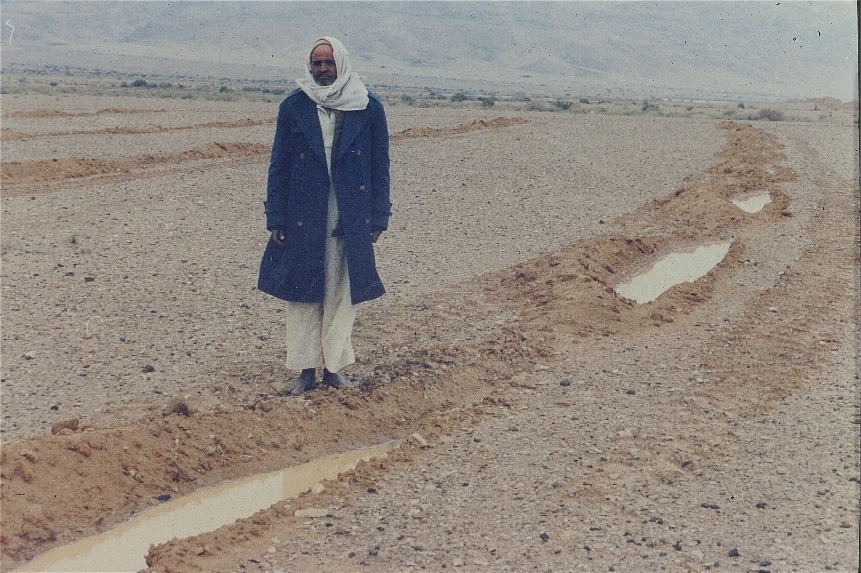
Egypt, Sinai, water collected in the micro-basins after 30 mm of rain
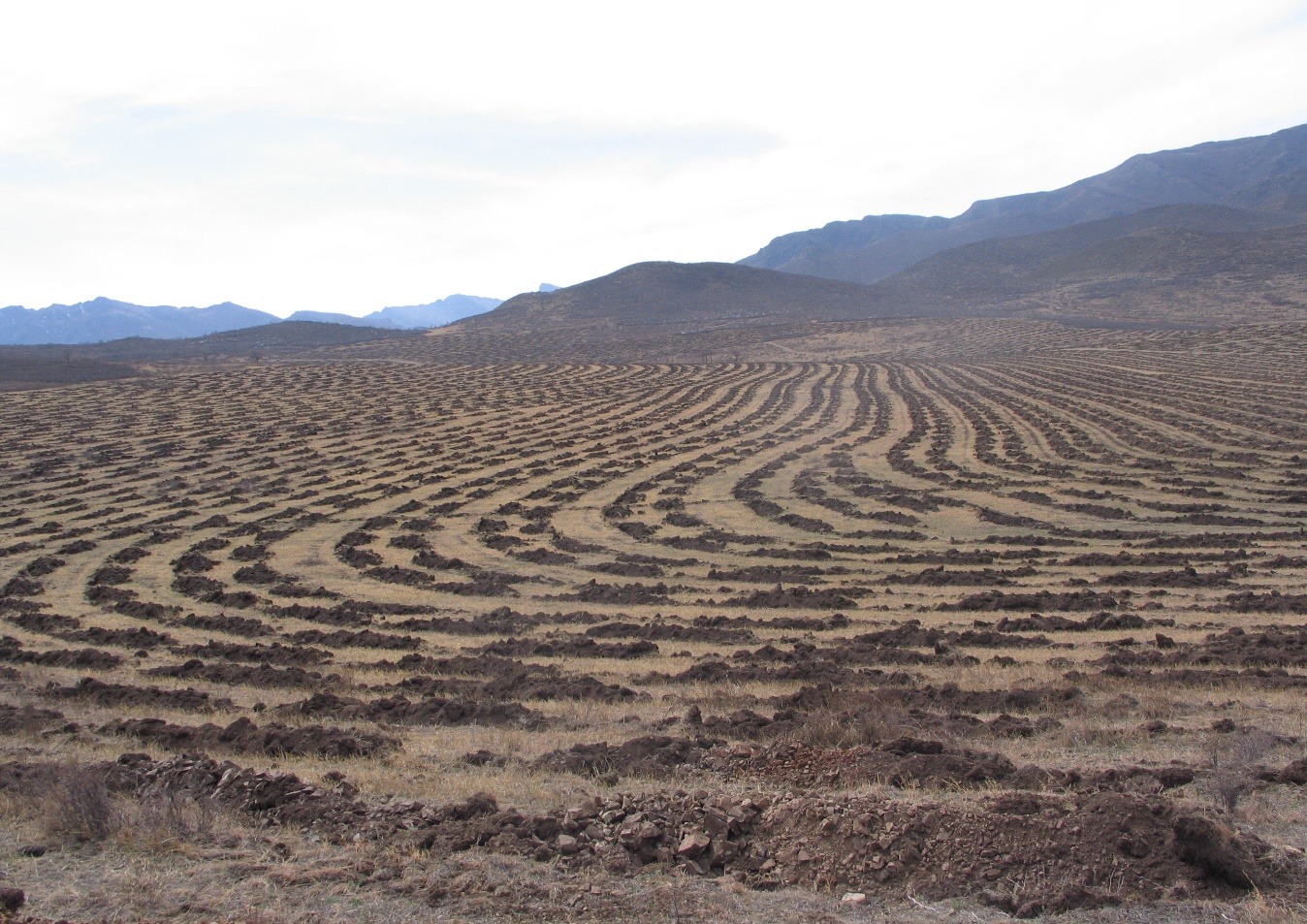
China, Inner Mongolia, soil just worked with the Vallerani System
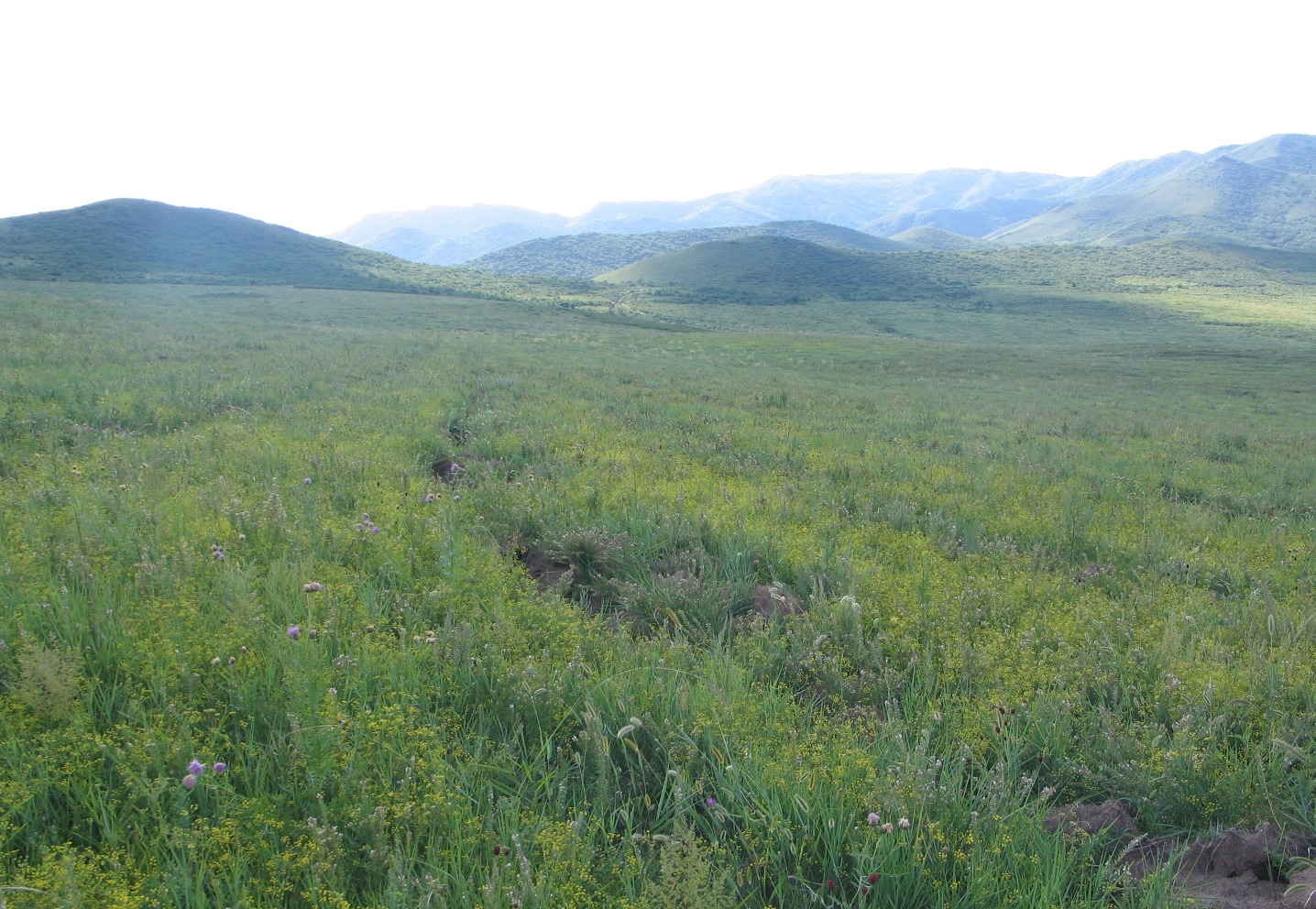
The same area 4 months later and after 180 mm of rainfall
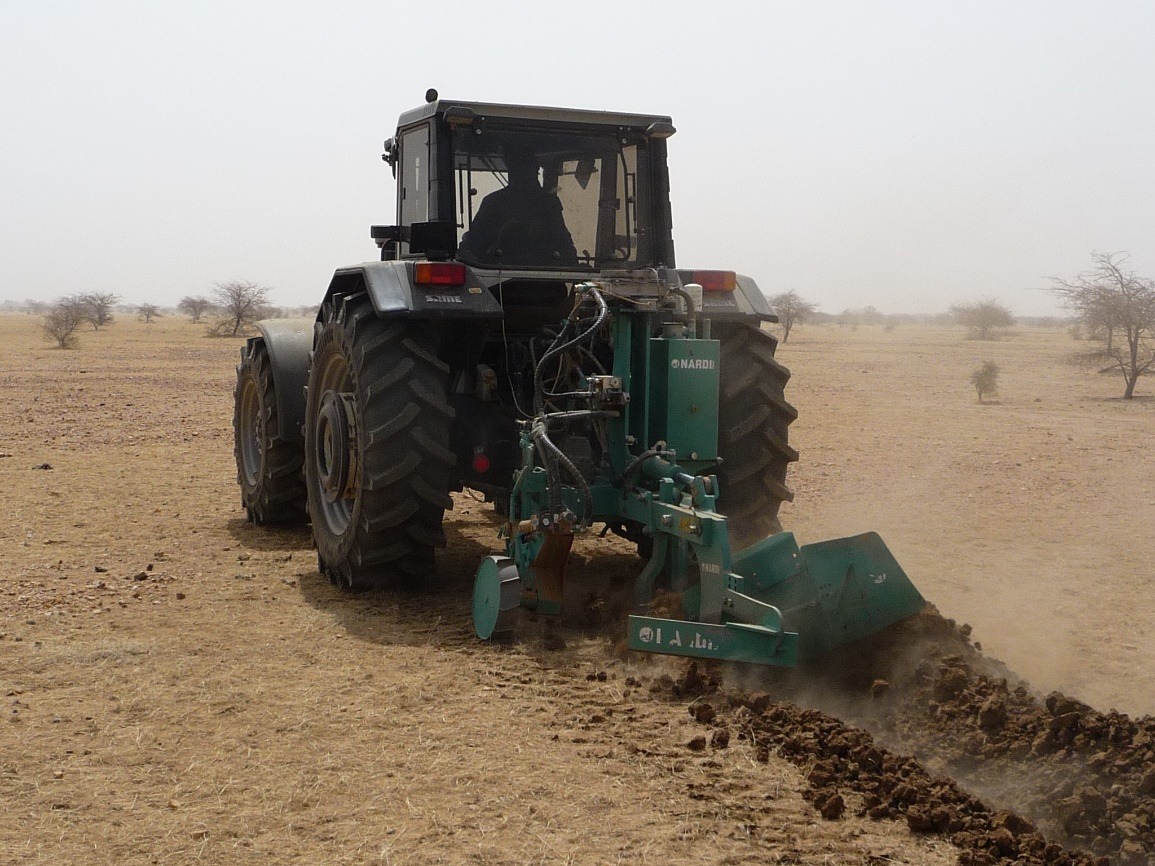
Burkina Faso, Delfino plow at work.
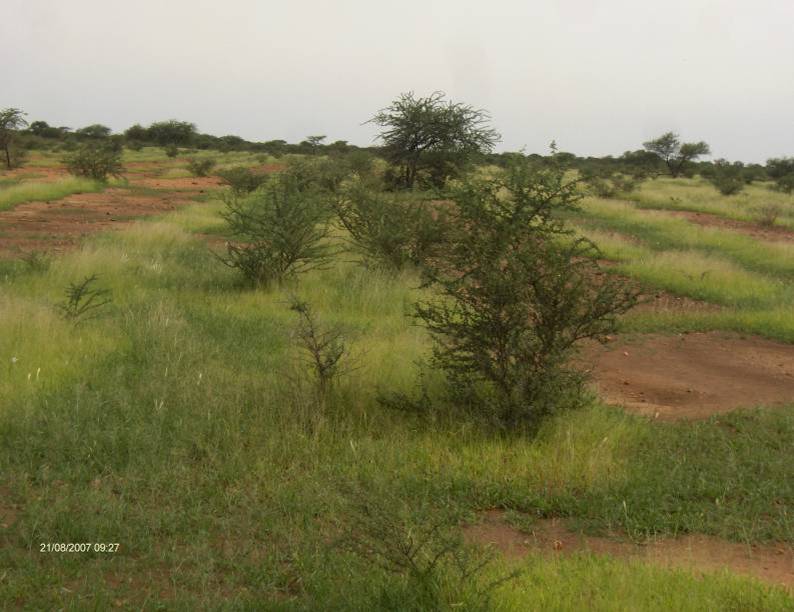
The same area 3 years later in the rainy season. The working lines are well visible both for the presence of new trees and abundance of grass.
2.4 Costs
Costs of intervention with the VS on a 5-year project with 9.000 ha/year worked with 3 tractors is Euro 3’945’000. This corresponds to an average cost of 88 Euros/hectare.
Cost includes planning, logistics, tractors, plows, interventions, and personnel expenses.
Appendix B gives a detailed table of costs and benefits.
2.5 Managing
Personnel leading and managing all the project-related activities are: Vallerani Venanzio and Vallerani Alessandro, Italy.
3 Restoring hydrological equilibrium in droughty and arid areas
3.1 History
An innovative new methodology for restoring hydrological equilibrium has been successfully tested in many parts of the world including some of the harshest and most arid areas[2],[3]. The methodology aims at restoring and regulating the natural pulsation of the atmosphere by using an apparatus that creates a variation of energy potentials in the atmosphere so as to re-establish the natural alternating cycles of rain and sun. The technology implies neither the use of chemical additives, such as required by the traditional cloudseeding technology, nor any environment impacting technology.
Starting from the 1960s numerous experiments were carried out[4], with the aim to verify the efficacy and the effectiveness of the technology in restoring the hydrological equilibrium and in producing rain. In 80% of the cases statistical significant results were obtained with a consequent reduction of drought and desertification advancement in the areas subjected to intervention. This resulted in an increase of the water supply available for civil use as well as for agricultural and farming activities that reflected also in a reduction of foods and agricultural products imports.
In the last 30 years such technology was successfully applied to restore hydrological equilibrium and to produce rain also in some of the most arid and desert areas of the planet, such as in the Arizona desert, in Namibia, in Eritrea and in Israel, obtaining all the time excellent results in reducing the drought and the advancement of the desertification[5].
In the Desert Greening project in Israel (1991-1992) the agriculture benefited from the abundant rain fallen after the interventions with a record in the agricultural productions.[6].
The 5-year project in Eritrea, performed in the period 1994-1999 (no operation was carried out in 1996), recorded, in parallel to an increase of seasonal precipitation, a reduction of food imports in the Country. In 1998 and 1999 high cereals productions (459.000 ton and 319.000 ton, respectively) were recorded, while in 2000, where rainmaking operations were no longer carried out, cereals production decreased to 71.000 ton with a corresponding increase of the imports to 281.000 ton in 2001[7]. In the years after the conclusion of the project, drought returned again in Eritrea due to scarce seasonal rainfall, and cereal production in 2002 was only 28% (54.000 ton) of the 1993-2001 average[8], and 87% less than the annual total utilization (416.000 ton) for 2003[9]. Returned drought affected also pastoralists, and due to lack of pasture for grazing the number of livestock decreased significantly.
3.2 How it works
The duration of the project could be estimated over five years. Interventions are planned to be done during the rainy season. All the interventions are aimed at stimulating and restoring the alternating cycles of rain and sun, and also to sustain and increase the natural production of rain. In case of areas characterised by no rainy and dry seasons timing and type of operations must be evaluated case by case.
Figure 1 reports an example of the potential results of interventions aimed at increasing rainfall in the rainy season. Black bars show the long-term (i.e. 30 years) average monthly rainfall. Red bars show potential increase of rainfall due to interventions.
Figure 1 – Rainfall increase during a rainy season, and comparison with long-term average rainfall
Size of the area affected by rain production is dependant on the type, size and number of the apparatus used. In good operational conditions and with standard sizes apparatus radius of the area would be up to 150-250 km, corresponding to a surface ranged from about 5 to 20 million hectares.
Figure 2 shows an example of a typical apparatus used during an operation to restore atmospheric pulsation and hydrological equilibrium. The device refers to an ongoing project started in 2008 aimed at restoring the natural atmospheric pulsation and the hydrological equilibrium in some parts of the SE African coast[10].
Figure 2 – Typical apparatus to restore hydrological equilibrium
In figure 3 cumulative rainfall during the (2010-2011) rainy season (black line), related to the interventions site in SE Africa, and average cumulative precipitation related to the (1978-2008) 30-yr period (thick red line) for the same site is reported[11]. Standard deviation (SD) related to the 30-yr period rainfall is also reported in the figure (thin red lines).
Figure 3 – Cumulative rain during (2010-2011) and (1978-2008) rainy seasons and statistical indicators
The cumulative (2010-2011) rainfall trend reported on the graph of the above figure 3 outlines the good response of the atmosphere to the interventions aimed at restoring the natural pulsation with a statistically-significant precipitation increase from around mid November on when compared to the 30-yr averaged rainfall data.
Figure 4 shows the atmospheric pulsation, characterized by rainy and sunny periods, at the interventions site both for the (2010-2011) and (1990-1991) rainy seasons[12].
Figure 4 – Weekly atmospheric pulsation for (2010-2011) and (1990-1991) rainy seasons
It can be observed from the above figure 4 the atmospheric pulsation behaviour of the (1990-1991) rainy season is very reduced, with some rain/sun cycles missing, when compared to that referred to the (2010-2011) rainy season, where interventions were performed.
3.3 Results
A 5-year project, aimed at restoring the hydrological equilibrium and increasing rainfall in prolonged droughty periods, may result in a reduction of water supply shortage, increase of crops and livestock farming.
Historical data available from the literature related to other similar projects, such as the 5-year rainmaking project performed in the Eritrea South-east Sahel, might give indications of a possible increased cereal production of about 60% in the periods where interventions to increase and sustain rainfall were carried out.
3.4 Costs
Total cost of the project over a 5-year period and with a coverage area of 5-20 million hectares is estimated to be 4.5 million Euros. Cost includes planning, logistics, instruments and interventions, and personnel expenses. Insurance costs are not included.
Appendix C gives a detailed table of costs.
3.5 Managing
Personnel leading and managing all the project-related activities are Francesco Laterza, Gianfranco Leoncavallo, and Roberto Maglione, Italy.
4 Integration of the two techniques
As previously exposed in the Introduction chapter, the aim of this project is to integrate these techniques in such a way that the individual benefits of the two techniques can mutually be enhanced by their coordinated application.
4.1 Mutual benefits of the two techniques
Even though the Vallerani System has shown, in almost 30 years during which it has been applied in various parts of the world, to bring great results also when used alone, it basically relies on the fact that even in very dry areas sooner or later rain will fall. If rain is completely lacking, water will not be collected in the micro-basins and thus also the tillage of young plants in the micro-basins has to be delayed till rainfall comes. Also, crop production which can be enhanced by the use of the Vallerani System depends almost completely on the availability of rainfall. If rain is poor, the system will still work, but it will take much longer to obtain practical results.
On the other hand, by using the rain increasing techniques exposed in chapter 3 in arid areas, one runs the risk of washing out the land, as water will simply flow on the surface to eventually collect in creeks and rivers without bringing too much benefit for such areas, and actually damaging the already precarious ecosystem which over the ages has adapted to little rainfall and relies on the fact that big rains very rarely hit such areas.
But if the land can first be worked with the Vallerani System, and hydrological equilibrium can be reestablished with the techniques to increase rain, it is our view that both systems can take mutual advantage thus speeding up the restoration of arid regions, to the extent that within a few years local populations will be able to move back to the land that has been abandoned due to lack of water. Pastures will be increased as well as crop production, and through targeted reforestation also the availability of firewood will increase, so allowing animal dung to be left on the soil by the locals and thus further increasing its fertility.
The increased vegetation will further help in reestablishing the natural rhythm of rainy seasons and dry seasons, which are the foundation of life in such areas.
We are confident that if enough land can be treated with the cooperation of these two techniques, a positive spiral of land improvement will be produced which will bring great benefits locally to the people and the ecosystem, as well as globally, since more vegetation means more rain and less drought, with possible effects also on the much debated global warming.
For a better understanding of how we intend to apply the two techniques, we now expose the case study of a hypothetical project in the sub-Saharan country of Chad.
4.1.1 Lake Chad case study
There is one important consideration that arises when comparing the coverage area of the 2 techniques. While the VS actively works the soil, the rain increasing techniques mainly work at an atmospheric level. As can be derived from the above presentations, the coverage area of the 2 techniques are very different in size, with 45’000 hectares worked with 3 tractors in 5 years with the VS, and up to 20 million hectares covered with the rain increasing techniques. It could be possible to consider working with more tractors, but to cover such wide an area the number of tractors would be in the order of hundreds if not thousands. This would notably raise costs and also organizational issues would become hard to deal with.
So, the idea we have had is to work with the two techniques in correspondence to an endorheic basin[13]. An endorheic basin is a closed drainage basin that retains water and allows no outflow to other bodies of water such as rivers or oceans. There are literally hundreds of such basins in the world, which can size from very small to very large. Some of these basins, especially those that are in arid areas, have attracted over the millennia communities of people who take advantage of the fact that precipitation during the rainy season won’t flow to the sea through rivers, but will stay in place, creating seasonal lakes or expanding many times the area of all-year-round lakes.
One example of such a basin is the Chad endorheic basin. It covers an area of approximately 2.434 million km², equivalent to 8% of the total area of the African continent. It expands over the countries of Chad, Niger, Nigeria, Cameroon, Central African Republic (CAR), Algeria, Libya, and Sudan. One important features of this basin is Lake Chad, which when at its maximum extension in the last century, covered an area of 26,000 km2, an area roughly the size of Rwanda or Macedonia.
Lake Chad is economically important, providing water to more than 20 million people living in the four countries that surround it (Chad, Cameroon, Niger, and Nigeria) on the edge of the Sahara Desert. But an increased demand on the lake’s water from the local population together with diminishing precipitation has caused its shrinkage over the past 40 years to less than 1,500 km2 (year 2000 data) as can be depicted on the following satellite pictures.
So, when working in such an area, we could take full advantage of the rain increasing techniques’ wide coverage area by guaranteeing that enough precipitation will fall in the Lake Chad area eventually increasing again its water level, while in the meantime it would be possible to build a wind barrier of trees with the VS which would guarantee that in the long term sand storms and the constantly advancing sand dunes of the surrounding deserts will not cover up Lake Chad[14]. Furthermore, the wind barrier would be composed of trees and pastures, thus providing firewood and food for livestock. 20 million people will directly benefit from such an operation, and also a general improvement in water availability in the surrounding area could be expected. Furthermore, having Lake Chad already been a self-sustaining great hydrological system, operations in that area will not be invasive and will not significantly change the existing ecosystem.
Other advantages that the project will bring would be to counteract the present social and ecological problems as stated in this quote from Wikipedia:
“The shrinking of the lake has also caused several different conflicts to emerge as to which countries that border Lake Chad have the rights to the remaining water. Along with the conflicts that involve the countries, violence is increasing among the lake’s dwellers. Farmers and herders want the water for their crops and livestock and are constantly diverting the water. The fishermen however want the remaining water in the lake to stay so they can continue to fish and not have to worry about the lake shrinking more and decreasing their already strained supply of fish. Furthermore the birds and animals in the area are threatened as they are important sources of food for the local human population.”
We would like to underline the fact that we have taken the example of Lake Chad just to give a practical idea of the benefits that our operations could bring in that specific area and in other areas with similar geography. But to actually work in that area would also include the planning of additional costs to guarantee the security of the staff involved in the operations.
However, there are many other similar locations across the five continents where similar operations could be carried out, and where potential benefits as those explained above could be expected.
Appendix A gives the Wikipedia list of endorheic basins in the world. Obviously not all of these basins are potential candidates for such an operation, but we believe that in many cases it would be advisable and in many others local population could benefit from it.
Furthermore, other regions not included in Appendix A, such as natural flood plains, could be evaluated as suitable places to carry out such operations.
4.2 Planned schedule
The plow of the Vallerani System to dig micro-basins can be used only during the dry season (about 180 days in warm areas, 120 days in cold areas) while the complementary operations (seed collection, sowing, interaction with local people, eventual pruning of plants, etc) can be planned all year round (when not depending on natural cycles).
We plan to use the rain increasing techniques only during the rainy season to guarantee that the latter will last the expected amount of time (dependant on location) and bring the expected amount of rain (also dependant on location). No such operation will be planned outside the rainy season, as this may cause disturbance to the local flora and fauna which base their life cycle on the rhythmic alternation of wet and dry seasons. The hydrological equilibrium restoration operations will be planned for 5 consecutive years to obtain best results.
4.3 Expected results
Within 5 years during which we plan to apply the Vallerani System together with the rain increasing techniques, we expect dramatic improvements in the vegetation cover for pasture, crop production and reforestation. This will increase sustainability for human life, as well as an increase in biodiversity. All these factors will in turn cause the reestablishment of the natural seasonal cycles which will not need any further human intervention, besides preservation. Land that had become unusable as well as unlivable will again become able to support small dwellings. Peoples that had been forced to move out of the land will be able to come back, thus diminishing human pressure on other areas with the consequence of also diminishing conflicts determined by competition for the depleted natural resources. Also diseases caused by famine, undernourishment and malnutrition will be drastically reduced. Droughts will be abated, and if preservation becomes an important issue for the local governments, economic advantages will be countless.
4.4 Global cost of the project
The total cost of the combined application of the two techniques presented in this document in an area like that of Lake Chad over a 5-year period, is estimated to be around 8.5 million Euro. Cost includes 3 tractors for the VS, planning, logistics, instruments and interventions, and personnel expenses for both techniques. Insurance costs and security costs (as would be advisable in the Lake Chad area) are not included. However, Mr. Vallerani has already worked in many countries of Africa, and personally knows European ambassadors and local politicians which could surely be of help to guarantee cooperation and security.
With this investment the water level of Lake Chad could be increased by the use of the rain increasing techniques, 45’000 hectares of land could be cultivated with wind breaking trees and crops by the use of the VS which would guarantee protection of the lake in the long term as well as provide food, firewood and pastures, 20 million people would improve their living conditions, biodiversity and animal life would increase, and one of the causes of the present conflicts would be mitigated.
-
The information on the Vallerani System has been collected from Mr. Vallerani’s website http://www.vallerani.com and from his recent book “Un delfino rinverdisce i deserti” (“A dolphin re-greens the deserts”) available for download on his website ↑
-
Maglione R, Sotgiu C, An Innovative Method of Weather Modification, presented to the VII International Conference on Cosmos and Biosphere, October 1-6, 2007, Sudak, Crimea, Ukraine.
-
Maglione R, Wilhelm Reich and the Healing of Atmospheres: Modern Techniques for the Abatement of Desertification, Natural Energy Works, Ashland, Oregon (USA) 2007.
-
Maglione R, Ibidem.
-
Maglione R, Ibidem. ↑
-
Jerusalem Post, 27 June 1992. ↑
-
FAO, Food Supply Situation and Crop Prospects in Sub-Saharian Africa, May 2003. ↑
-
FEWS NET, Emerging Food Security Crisis. Eritrea Food Security Update, August 31, 2002. ↑
-
FAO, Ibidem. ↑
-
Maglione R, Restoring Atmospheric Pulsation in SE African Countries. An Ongoing Project, Unpublished Report, December 2011. ↑
-
Maglione R, Ibid. ↑
-
Maglione R, Ibid. ↑
-
The following information has been taken from Wikipedia ↑
-
This kind of operation with the VS has been described in his book “Un delfino rinverdisce i deserti” (“A dolphin re-greens the deserts”) available for download on the VS website. ↑